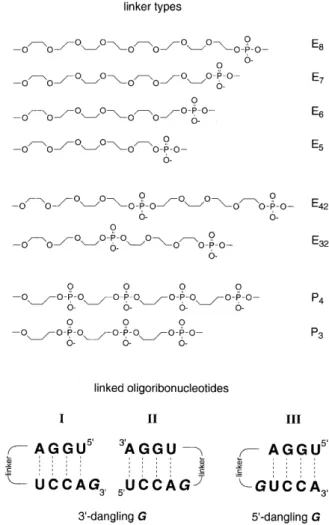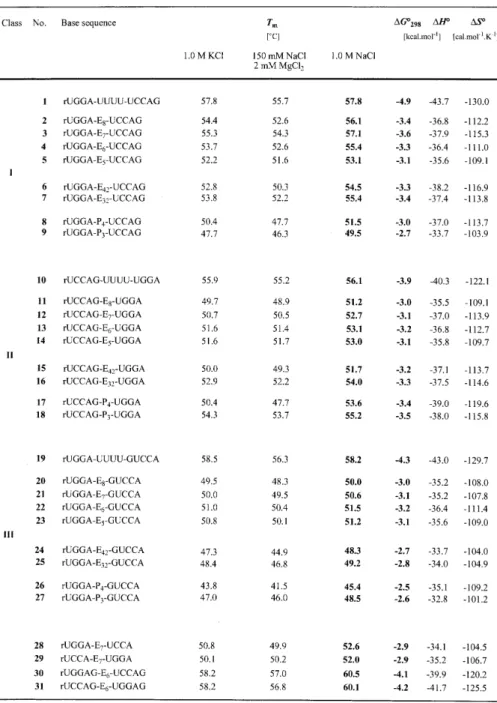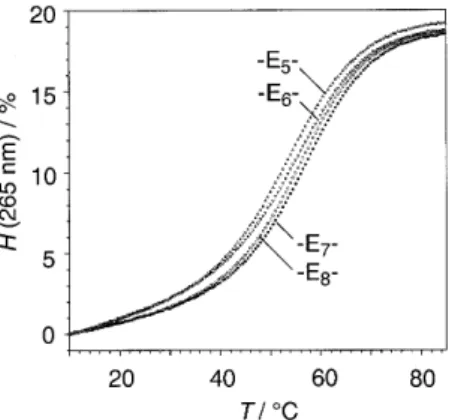Flexible non-nucleotide linkers as loop replacements in short double helical RNAs
Texte intégral
(2) 1860 Nucleic Acids Research, 2000, Vol. 28, No. 9 the 2′-O-silyl acetyls was afforded by treatment with tetrabutylammonium fluoride trihydrate (TBAF.3H2O) in THF (1 M, 0.90 ml) for at least 12 h at room temperature. The reaction was quenched by the addition of Tris–HCl (1 M, pH 7.4, 0.95 ml). The volume of the solution was reduced to 1 ml and directly applied on a Sephadex G 10 column (30 × 1.5 cm) controlled by UV-detection at 260 nm. The product was eluted with water and evaporated to dryness. All oligoribonucleotides were purified by ion-exchange chromatography on a MONO Q HR 5/5 column. Flow rate: 1 ml/min; eluant A: 10 mM Na2HPO4 in H2O (pH 10.5); eluant B: 10 mM Na2HPO4/1 M NaCl in H2O (pH 10.5); detection at 260 nm; gradient I (for checking the purity of crude products after deprotection): 30 min 0–100% B in A; gradient II (for purification): ∆30% B in A within 30 min. Fractions containing the purified oligonucleotide were desalted by loading onto a C18 SepPak cartridge (Waters/Millipore), followed by elution with 0.1–0.2 M (Et3NH)HCO3, water, and then H2O/CH3CN (6/4). Combined fractions containing the oligonucleotide were lyophilized to dryness. The masses expected have been confirmed for all oligoribonucleotides by MALDI-TOF mass spectrometry. Thermal denaturation studies Absorbance versus temperature profiles were recorded at 265 nm on a Cary-100 spectrophotometer equipped with a multiple cell holder and a Peltier temperature control device. Sample preparation: oligonucleotides were lyophilized to dryness, dissolved in the corresponding buffer from stock solutions, and subsequently degassed by treatment with ultrasonics. A layer of silicon oil was placed on the surface of the solution. Concentrations were 4 µM. Data were collected after a complete cooling and heating cycle at a rate of 0.5°C/min. Melting transitions were reversible for all sequences. Hyperchromicities of melting profiles were in a range of 16–19% for all tethered hairpin sequences and of 11–14% for the reference sequences with nucleotidic loops. Concentration independence of the melting temperature was demonstrated for the hairpin sequences rUGGA-E7-UCCAG and rUCCAG-E6-UGGA. Values of ∆H° and ∆S° were derived from a two-state van’t Hoff analysis by fitting the shape of the individual absorbance versus temperature curve according to Breslauer (16) and Turner (17,18). Circular dichroism CD spectra were recorded at 20°C on a Jasco-710 spectropolarimeter equipped with a Peltier temperature control device; samples were prepared as described for UV samples. RESULTS AND DISCUSSION The requirement for minimum interference of the synthetic loop replacements with the nucleobases implies that the most reasonable bridging spans from one terminal ribose phosphate to the phosphate group of the opposite strand. That offers a simple synthetic strategy: commonly available diols are derivatized to the corresponding α-tritylated ω-phosphoramidite linkers which are then incorporated into oligoribonucleotides following standard procedures (19).. Figure 1. Constitution of linkers and base sequences of corresponding hairpin oligoribonucleotides.. Sequence design All 31 hairpin oligoribonucleotides listed in Table 1 possess the same base sequence as core duplex, namely 5′-rUGGA pairing with 5′-rUCCA. The sequences are subdivided into three different classes (I, II and III; Fig. 1, Table 1). Two of them, class I (2–9) and class II (11–18) oligoribonucleotides possess a dangling guanosine attached to the 3′-end of rUCCA. However, the distinction is made by the position of their loops. On the one hand, such a design enables the optimization of linkers for a simple blunt-end duplex (I) as well as for a duplex end with an unpaired nucleotide incorporated into the loop (II). On the other hand, as these oligoribonucleotides are of the same base sequence, differences in their thermal stabilities are to be attributed to specific linker-based properties and not to sequence-dependent ones. In oligoribonucleotides of class III (20–27) an unpaired guanosine is also incorporated into the loop; however, this dangling nucleotide is attached to the 5′-end of rUCCA. The oligoribonucleotides 1 (I), 10 (II) and 19 (III) are reference sequences with a tetrauridine nucleotide loop; the oligoribonucleotides 28–31 are reference sequences in order to understand stability differences of the same core duplex arising from a combination of influences that are dangling bases,.
(3) Nucleic Acids Research, 2000, Vol. 28, No. 9 1861. Table 1. Thermal melting temperatures and thermodynamic data of hairpin oligoribonucleotides with non-nucleotide loop replacements and corresponding reference sequences measured in aqueous HPO42– buffer solutions with different kinds of cations at pH 7.0. different linker positions and solvatization effects of double helix ends. Linker constitution, linker length and effects on double helix stability Linker constitution. Three types of flexible synthetic linkers are investigated in the present study. They are derived from oligo(ethylene glycols) (Ex), oligo(ethylene glycol)-phosphates (Exy) and 3-hydroxypropane-1-phosphates (Px). Their structural formulas are depicted in Figure 1 in the order of decreasing hydrophobicity. Linkers derived from 3-hydroxypropane-1phosphates directly mimic the charged P-O3′-C3′-C4′-C5′-O5′-P. nucleotide backbone. They are more demanding with regard to stereoelectronic and conformational aspects than ethylene glycol-based linkers. Linker length. For A-RNA double-helical structures, a distance analysis shows that the phosphor–phosphor bridging distance is 18 Å between a nucleotide and its pairing partner (20). This distance is ~1–2 Å more for the same nucleotide to a nucleotide attached at the 5′ end of its pairing partner but ~1–2 Å less to a corresponding nucleotide at its 3′-end. In the DNA series, the length of the optimum ethylene glycol-based linker (E7) in extended conformation (27 Å) exceeds the straight-line.
(4) 1862 Nucleic Acids Research, 2000, Vol. 28, No. 9. Figure 2. Absorbance versus temperature profiles of rUGGA-Ex-UCCAG, (x = 5–8), 2–5; 4 µM, 1 M NaCl, 10 mM Na2HPO4, pH 7.0; H = hyperchromicity.. Figure 3. Selection of hairpin oligoribonucleotides (3, 13, 28–31) containing the optimized oligo(ethylene glycol) linkers: influence of different linker positions, 3′-dangling bases and solvatization effects on double helix stablity.. distance to be spanned (17 Å) (15). This can be reasoned as the starting vectors of bridging and the preference for a helical conformation of oligo(ethylene glycols) in solution (21) has to be taken into account. Furthermore, as there is evidence that linkers of single tris- or tetrakis(ethylene glycol) units distort the geometry of the terminal base pair, linkers of these lengths are not included in the present RNA study (22).. of a linker with tetrauridine in class II and class III oligoribonucleotide hairpins (Tm: 10 > 13; 19 > 22). Thereby, formation of an additional U–G base pair within the pentanucleotidic loop structure is likely (10; 19).. Effects on RNA double helix stability. With respect to the three oligoribonucleotide classes I, II and III, the thermal and thermodynamic data listed in Table 1 show small but distinct differences caused by structure and length of the linkers (see also Fig. 2). Concerning the family of oligo(ethylene glycol) tethered oligoribonucleotides, linker length was increased stepwise by single ethylene glycol units from pentakis- to octakis(ethylene glycol) (E5–E8). The optimum linker is derived from heptakis(ethylene glycol) provided that the duplex end to be bridged comprises solely the terminal base pair (3); the optimum linker is derived from hexakis(ethylene glycol) if a dangling unpaired nucleotide is incorporated into the loop (13, 22). For class I and class III oligoribonucleotides, linkers based on tris- and tetrakis(ethylene glycol)-phosphate or 3-hydroxypropane-1-phosphate are inferior to their heptakis- and hexakis(ethylene glycol) counterparts, respectively (Tm: 3 > 6–9; Tm: 22 > 24–27). However, if an unpaired nucleotide is incorporated into the loop at the 3′-end (II), these linker types lead to slightly higher stabilities of the corresponding hairpin structures (Tm: 13 < 16–18). The reason for this reversed behavior is not yet clear, however, a detailed NMR analysis of a hexakis(ethylene glycol) linked class II hairpin is currently in progress in the laboratory of B. Jaun (ETH Zürich) and should lead to deeper insight. Comparison to nucleotide loops. All duplexes in the present study with non-nucleotide loop replacements are less stable than their corresponding reference sequence comprising a nucleotide loop. The difference in thermal stability between the optimum heptakis(ethylene glycol) linked sequence and the one containing a tetrauridine loop is <1°C (Tm: 1 > 3), however, it is reflected clearly in a ∆∆G°298 value of 1.3 kcal/ mol. The differences are of the same order for the replacement. Effects of cations In order to investigate whether the correlation between double helix stability and structure of the linkers is influenced by the kind of cations in aqueous buffer solutions, we performed Tm determinations in three different buffer systems (10 mM HPO42–, pH 7.0): 1.0 M NaCl; 0.15 M NaCl, 2 mM MgCl2; and 1.0 M KCl (Table 1). Moreover, a 1.0 M LiCl buffer (10 mM HPO42–, pH 7.0) has been tested additionally for the sequences numbered 2–5. The data verify that in all buffer systems the same dependence of duplex stability on linker length and structure is observed. Therefore, no specific chelating of cations within the synthetic loop replacements is ascertainable (Table 1). Linker position, dangling bases and solvatization of helix ends Figure 3 depicts a selection of hairpin oligoribonucleotides containing the optimized oligo(ethylene glycol) linkers. All six sequences are of the same core double helix rUGGA/rUCCA, however, the position of loop replacements and the number of dangling unpaired bases is varied. The well-known feature that dangling bases at the 3′-end enhance the stability of oligoribonucleotide duplexes (17) is correctly reflected in the melting temperatures Tm of the six sequences (Tm: 28 < 3 < 30; 29 < 13 < 31), even if the unpaired guanidine becomes part of the loop (Fig. 3). Interestingly, sequence 3 melts 4°C higher than sequence 13, both sequences showing identical CD spectra. We do not mainly attribute this distinction to the different linker positions (Tm: 28 ≈ 29; 30 ≈ 31) or to the different linker lengths (Tm: 3 ≈ 4; 12 ≈ 13), we rather render solvatization at the unbridged helix ends responsible. Solvatization of a helix end that comprises a dangling unpaired base is energetically more favorable than solvatization of a blunt-end terminal base pair. In the latter case the hydrophobic π-electron system is fully exposed to the aqueous solution, whereas an unpaired dangling base shields this plane and provides a better transition to the hydrophilic environment by formation of hydrogen.
(5) Nucleic Acids Research, 2000, Vol. 28, No. 9 1863. bonds between the dangling base and water molecules (23,24). These considerations are further supported by the observation that the differences in stability between class I and class II oligo(ethylene glycol) linked hairpins are more pronounced if their core duplexes consist of a low number of base pairs compared to the ones consisting of a higher number. CONCLUSIONS In the present study oligo(ethylene glycol) linkers have been systematically investigated as loop-replacements in short hairpin oligoribonucleotides. According to the criterion of highest duplex stability the optimum linker is the one derived from heptakis(ethylene glycol), provided that the duplex end to be bridged comprises solely the terminal base pair; it is derived from hexakis(ethylene glycol) if a dangling unpaired nucleotide is incorporated into the loop. In general, ethylene glycol-based linkers are superior to other commonly used flexible linkers. Only if a dangling unpaired nucleotide at the 3′-end is part of the loop, linkers based on tris(ethylene glycol)-phosphate or 3-hydroxypropane-1-phosphate result in hairpins of slightly higher stability. Importantly, the correlation between linker constitution and stability of the corresponding oligoribonucleotide is independent of the kind of counter ions present in the aqueous buffer. We consider the results to assist in the selection of a proper linker system for the various applications encountered in both fundamental RNA research and pharmaceutical development (2,3,8,12,14,25). ACKNOWLEDGEMENTS R.M. thanks Prof. Eschenmoser (Zürich) and Prof. Falk (Linz) for generous hospitality in their laboratories. We thank Dr Krishnamurthy (Scripps, CA) for mass analyses and Prof. Grubmayr (Linz) for critical comments on the manuscript. R.M. acknowledges the Austrian Academy of Science for an APART fellowship (Austrian Programme for Advanced Research and Technology). This work was supported by the Austrian Science Fund (P13216-CHE), Vienna.. REFERENCES 1. Seitz,O. (1999) Angew. Chem. Int. Ed. Engl., 111, 3466–3469. 2. Benseler,F., Fu,D.-j., Ludwig,J. and McLaughlin,L.W. (1993) J. Am. Chem. Soc., 115, 8483–8484. 3. Thomson,J.B., Tuschl,T. and Eckstein,F. (1993) Nucleic Acids Res., 21, 5600–5603. 4. Wu,X. and Pitsch,S. (1998) Nucleic Acids Res., 26, 4315–4323. 5. Dempcy,R.O., Kutyavin,I.V., Mills,A.G., Lukhtanov,E.A. and Meyer R.B. (1999) Nucleic Acids Res., 27, 2931–2937. 6. Wiederholt,K. and McLaughlin,L.W. (1999) Nucleic Acids Res., 27, 2487–2493. 7. Rajur,S.B., Robles,J., Wiederholt,K., Kuimelis,R.G. and McLaughlin,L.W. (1997) J. Org. Chem., 62, 523–529. 8. Micura,R., Pils,W. and Grubmayr,K. (2000) Angew. Chem. Int. Ed. Engl., 112, 922–925. 9. Micura,R. (1999) Chem. Eur. J., 5, 2077–2082. 10. Lewis,F.D., Liu,X., Wu,Y., Miller,S.E., Wasielewski, Letsinger,R.L., Sanishvili,R., Joachimiak,A., Tereshko,V. and Egli,M. (1999) J. Am. Chem. Soc., 121, 9905–9906. 11. Bevers,S., O’Dea,T.P. and McLaughlin,L.W. (1998) J. Am. Chem. Soc., 120, 11004–11005. 12. Ma,M.Y.-X., Reid,L.S., Climie,S.C., Lin,W.C., Kuperman,R., Sumner-Smith,M. and Barnett,R.W. (1993) Biochemistry, 32, 1751–1758. 13. Durand,M., Chevrie,K., Chassignol,M., Thuong,N.T. and Maurizot,J.C. (1990) Nucleic Acids Res., 18, 6353–6359. 14. Moses,A.C. and Schepartz,A. (1997) J. Am. Chem. Soc., 119, 11591–11597. 15. Rumney,S. and Kool,E.T. (1995) J. Am. Chem. Soc., 117, 5635–5646. 16. Marky,L. and Breslauer,K. (1987) Biopolymers, 26, 1601–1620. 17. Xia,T., Mathews,D.H. and Turner,D.H. (1999) In Söll,D., Nishimura,S. and Moore,P. (eds), Comprehensive Natural Product Chemistry, Vol. 8. Elsevier, Oxford, UK, S. 21–47. 18. Petersheim,M. and Turner,D.H. (1983) Biochemistry, 22, 256–263. 19. Beaucage,S. and Iyer,R. (1992) Tetrahedron, 48, 2223–2311. 20. Haasnoot,C.A.G., Hilbers,C.W., van der Marel,G.A., van Boom,J.H., Singh,U.C., Pattabiraman,N. and Kollman,P.A. (1986) J. Biomol. Struct. Dyn., 3, 843–857. 21. Abe,A. and Mark,J.E. (1976) J. Am. Chem. Soc., 98, 6468–6476. 22. Gao,H., Chidambaram,N., Chen,B.C., Pelham,D.E., Patel,R., Yang,M., Zhou,L., Cook,A. and Cohen,J.S. (1994) Bioconjug. Chem., 5, 445–453. 23. Williams,D.H. (1991) Aldrichimica Acta, 24, 71–80. 24. Auffinger,P. and Westhof,E. (1998) J. Biomol. Struct. Dyn., 16, 693–707. 25. Ma,M.Y.-X., McCallum,K., Climie,S.C., Kuperman,R., Lin,W.C., Sumner-Smith,M. and Barnett,R.W. (1993) Nucleic Acids Res., 21, 2585–2589..
(6)
Figure



Documents relatifs
Looking at the key demand reduc- tion measures in the MPOWER and NCD tobacco control best buys, as in- dicated in the 2015 WHO Report on the Global Tobacco Epidemic (8), there
For a pair of semilinear PDEs in one space dimension ([T 2], [McLPT]) and for nonresonant systems of three such equations ([JMR 4]) the weak limit of the solution is determined by
New Brunswick is increasing its training of medi- cal students with the opening of the Saint John Campus of Dalhousie University’s medical school.. At the same time,
2 Until a refrigerator-stable vaccine becomes available, however, varicella vac- cine will not be incorporated into the recommend- ed immunization schedule in Canada, as most
Les donnees presentees dans le tableau concernent les demandeurs qui ant presente une demande par l'entremise de l'ARC seulement et n'incluent pas les demandeurs qui ont presente
1: Embellecedor de esquinas inoxidable Según el modelo 2: Escalera inoxidable Fija - 3 Escalones antideslizantes 3: Escalera de madera Posibilidad de reajustar la escalera de
The lower bound in (6) will be compared to the upper bound in (3) to prove that PDF with random switch achieves capacity to within 1 bit; the one in (7) with the one in (4) to
We determined the capacity of the linear deterministic approximation of the Gaussian noise channel at high SNR, by showing that random switch and correlated non-uniform input bits